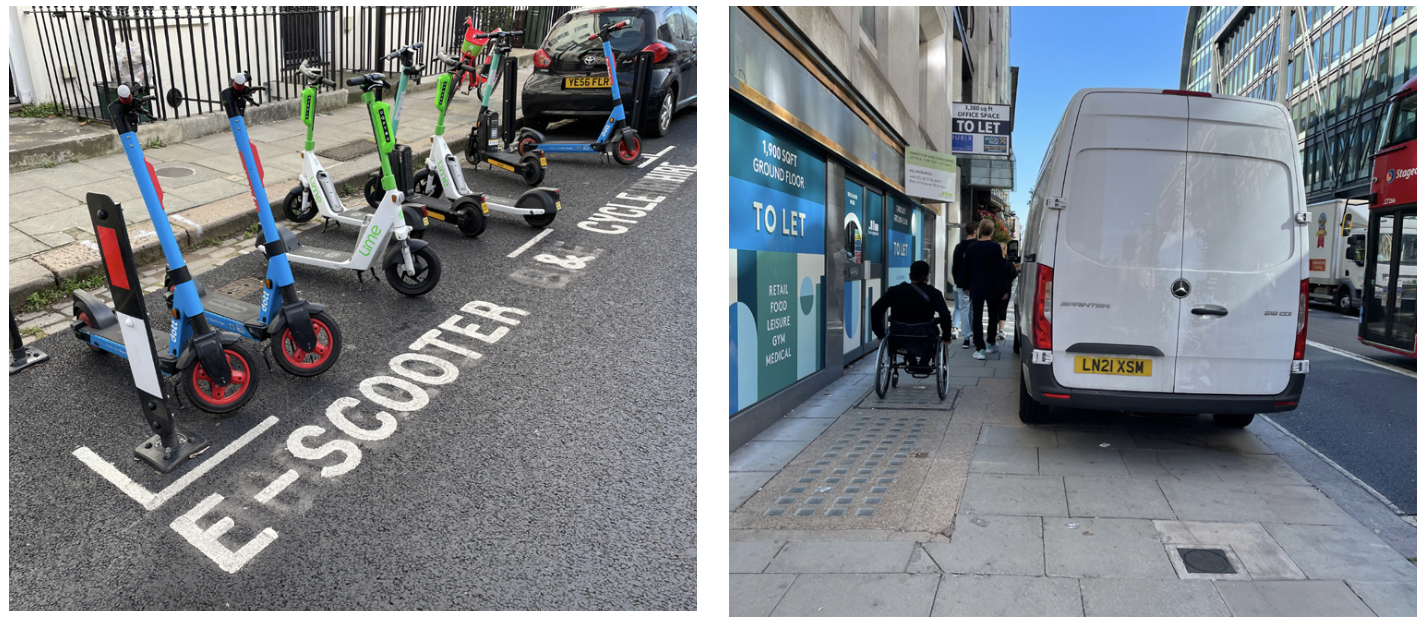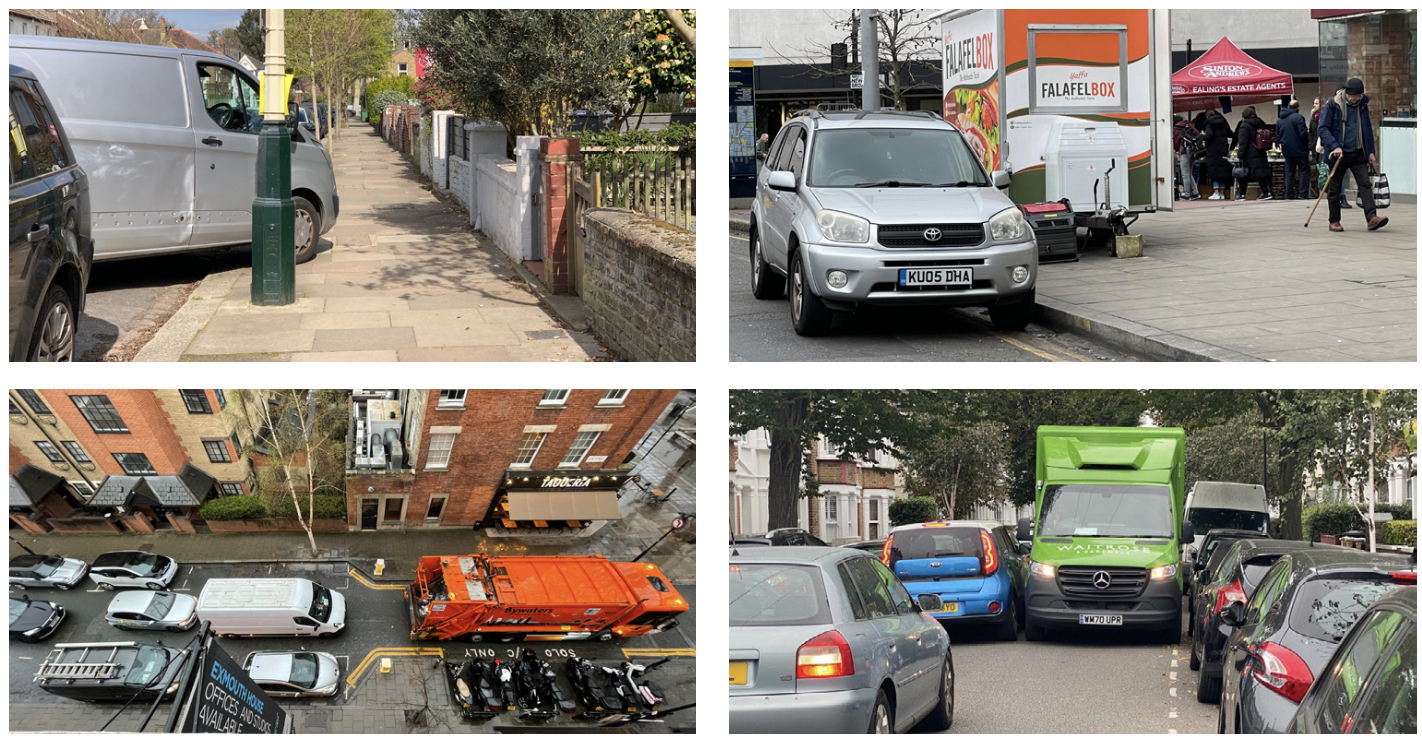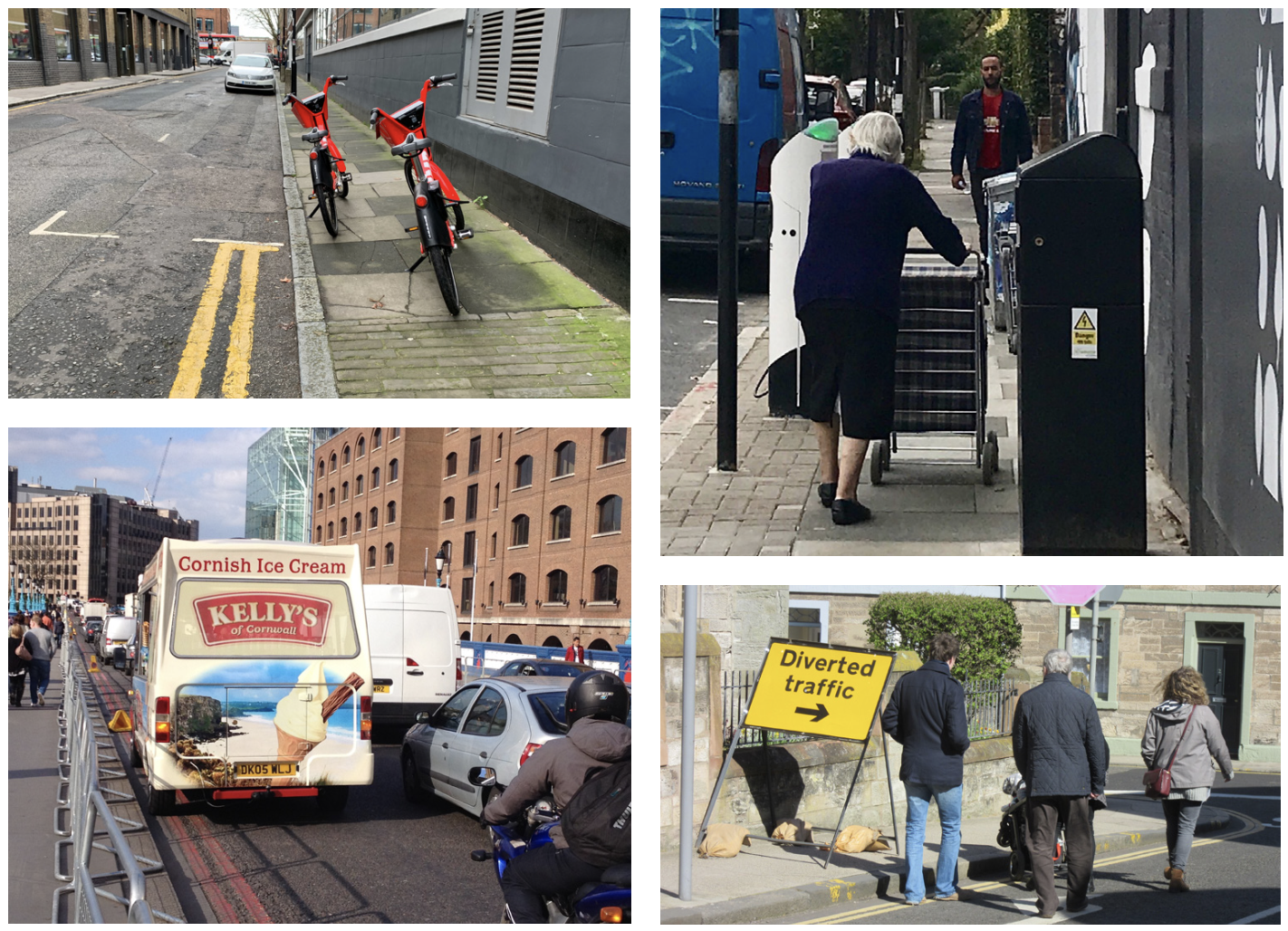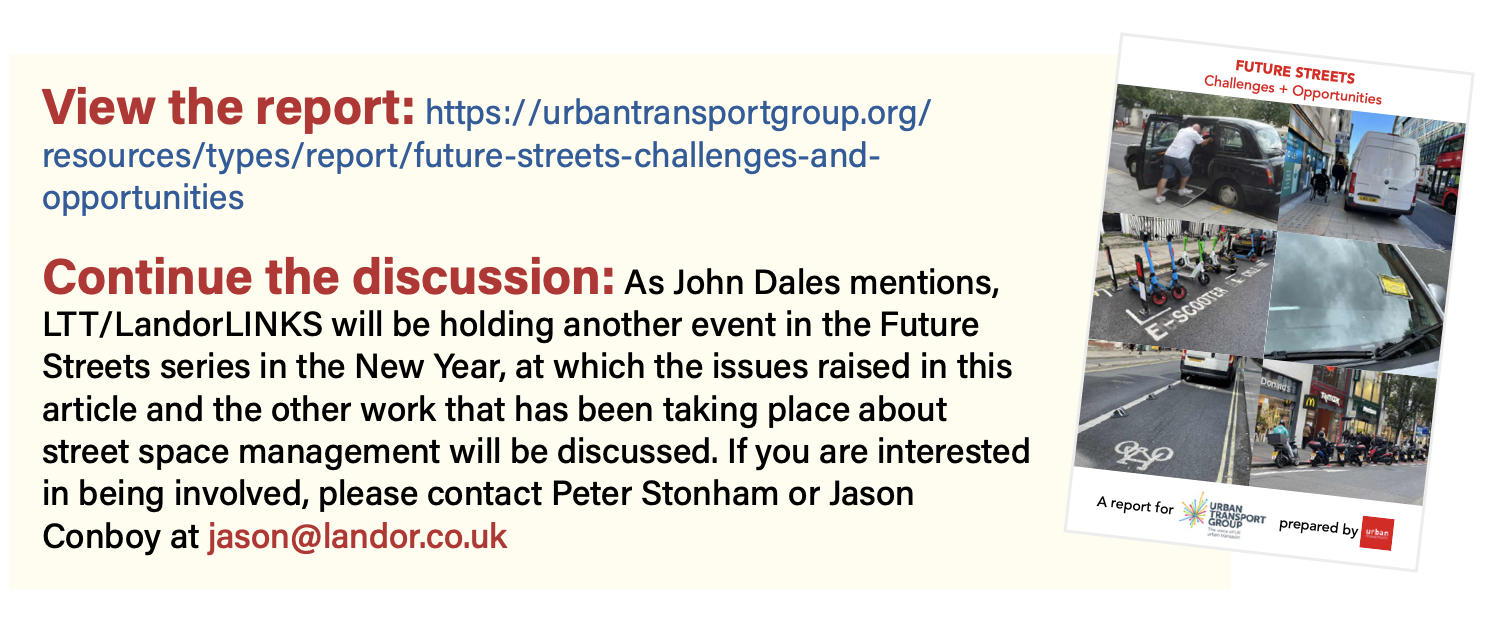TAPAS.network | 17 October 2022 | Commentary | John Dales
Designing streets is one thing, managing them is another: we need to get much better at it ASAP

There’s obvious growing interest in addressing the issue of street space and kerbside management, to ensure that the best and most efficient use is made of what is an often under-valued public asset, says . Having himself just produced a new report on the subject, he looks at what it identified as the key challenges and how progress can be made in tackling them.
MY LAST-BUT-ONE LTT article in July (in LTT849) asked the question, “How can we get a grip on the kerbside?” It referred to something else I’d written in these pages back in February 2019 (LTT766). This was my observation that, “To be frank, the kerbside in most towns and cities is a basket case; a shambles. The real-world use of the kerbside typically bears no relation to what was intended”.
Regular readers will also know that what I write about in LTT is often inspired by the projects or topics that are uppermost in my mind because of my day job. Were you therefore to conclude that, both in 2019 and presently, I was/am in the mode of exploring the matter of how kerbside access is managed, and, indeed, how it isn’t, you’d have hit the nail on the head.
Three years ago, what I was working on was a report for the Department for Transport (DfT) entitled Future Streets: Designing and Managing the Kerbside. That report was never formally published, although I was cleared to talk about its principal findings and recommendations at a number of events. The fact that I did so led indirectly to my being appointed, earlier this year, to prepare a paper for the Urban Transport Group (UTG) entitled Future Streets: Challenges and Opportunities. This has recently been published and can be seen and downloaded online courtesy of UTG (see link at the end of this article).
Earlier this month, indeed, in the previous issue of LTT, the paper was covered as an important news item in LTT854, with the editor promising that, in this next edition, I would present fuller coverage of its contents along with my take on what should happen next. Since that promise was made in text that was both red and bold, it plainly must be fulfilled. However, before I do so, let me observe that it’s by no means just the UTG who are actively interested in how our streets will work in future. At almost the same time as I started research for my paper, the DfT was commissioning a Discovery project into the Provision of Kerbside Management, and TRL (formerly the Transport Research Laboratory) was assembling “a taskforce to seek ways to optimise the management of the kerbside”. A TRL press release announced in May this year that the taskforce would “start the debate with a White Paper”, though I don’t think it’s been published yet.
What struck me in speaking to the DfT officers managing the Discovery project, and the consultants undertaking the work (Deloitte), as well as in reading the TRL press release, was that we all seem to be coming from, and trying to get to, similar places. For example, all five of the key opportunity areas identified by the Discovery project chime with the findings from my own research. Though the Discovery is yet to be published, I was given permission to list those opportunity areas in my paper. Similarly, when TRL’s Paul Campion notes that “the kerbside was left behind when urban environments were evolving and maturing as living spaces for people” this echoes the following observation made in my UTG paper:
“It took the publication of the first Manual for Streets (2007) to remind us of the importance of the ‘place’ functions of streets, as distinct from their ‘movement’ functions. However, while that understanding has changed how we approach the design of streets, it seems to have done comparatively little to change how we manage them, the problems arising from which are arguably most evident at the kerbside.”

At which point, it may be worth confessing that, in writing my UTG paper, I initially found it hard to make a clear distinction between ‘the street’ as a whole, and that part of it that is called ‘the kerbside’. I realised that this was because most of the issues I was trying to shed light upon – those of street management, rather than design – are located at the kerbside: i.e. the interface between the carriageway and footway; between the ‘movement’ and ‘place’ functions of streets. Effective kerbside management is essential if the full potential and value of streets are to be maximised. Put another way, we can do all we like in terms of how streets are laid out – the spatial arrangements – but that will not in itself lead to them being used as designed.
What’s more, observation of almost any urban street you care to think of will reveal that we can introduce all the street and kerbside access regulations we like, but still fail to achieve its use as intended. For example, to describe the flouting of waiting, loading and bus lane regulations as commonplace is to do that word full justice. Think of it: the purpose of such regulations is to prevent something happening that shouldn’t; and yet the significant scale of the fines that are gathered because ‘the regs’ are not observed has, sadly, become a key source of revenue for many local authorities. While a case can possibly be made that some Penalty Charge Notices (PCNs) may be issued with less justification than others, the simple fact is that there are a lot of them about, underlining the extent of ‘abuse’ going on.
In an ideal world, streets would be used in the ways they’re designed for, and only in those ways. That the street world is not ideal is sometimes because of design flaws. But the predominant cause of streets not working as well as they could, and should, is that some users don’t act as they were meant, and ought to. Better and/or tougher enforcement is usually held up as the solution, but since this is plainly only partially successful (at best) we clearly need to consider what else we should do if we care about getting the best out of our streets. Indeed it is comprehensive change along these lines that the UTG paper and the DfT and TRL initiatives are seeking to promote.
The recommendations in the UTG paper stem from consideration of two basic forms of evidence: documentary and spoken. The former was an exploration of the different ways in which published (and unpublished) policies, strategies, reports and guides – as well as known examples of new practice – bear upon the challenges and opportunities at the kerbside. The latter comprised a series of interviews with more than 20 practitioners, academics and other interested parties, again seeking to identify challenges and opportunities.
Without having any particular number in mind – though I always try and avoid the usual obvious ones of three, five or ten – I derived a total of eight recommendations from my researches. As is always the case when listing things, and even if prefaced by disclaimers, there’s a tendency to read the first-listed as the most important, and so on. With that in mind, I have put in order my eight as follows, based upon how I feel about them today; though that could easily change tomorrow.
1 Defining ‘the Kerbside’
Here is the definition of ‘a street’ given by the first Manual for Streets (MfS, 2007) - “A highway that has important public realm functions beyond the movement of traffic...” This recognised their inherent complexity, and helped streets be better understood, and designed. It has not, however, helped get them appreciably better managed; not least because that wasn’t MfS’s purpose. Defining the kerbside as a place of shared endeavour and of potential mutual benefit – not just a line between footway and carriageway – should be considered a vital step in changing the street management status quo. As much as anything, an agreed functional definition of the kerbside would help establish it as a place for which someone should have appropriate responsibility.
This recommendation is a key finding of Deloitte’s work on the DfT Discovery project: that “a shared, formal definition for managing access to the kerbside does not exist and is required”. This should be considered vital to ensuring that each of the many different actors at the kerbside - and, by extension, in streets as a whole - have a common, shared understanding of the roles that they and others play, and therefore of the fact that co-operation and partnership is not only possible, but essential.
2 Street/Kerbside Management Strategies
The professional anonymity of the kerbside is reflected in the fact that only one UK local authority (Southwark) has sought to have a defined Kerbside Strategy as far as I know – and even that one is still only in draft after five years! This should be astonishing, yet it isn’t, because it’s hard to feel strongly about the lack of a thing that nobody else already has. If ‘the Kerbside’ isn’t formally recognised, why would (or how could) there be a strategy for managing it? However, if streets are to be better managed, it’s essential that local authorities should have an agreed framework for co-ordinating activities by different departments and by other partners, agencies and third parties, including in the private sector.
Streets, which are inherently complex environments, will surely benefit greatly from strategies designed to co-ordinate and prioritise these activities according to established objectives, so as to increase efficiency, minimise conflict, maximise value, and make best use of limited resources. It is hoped that the value of such strategies will be recognised in the new Manual for Streets.
3 Policy Coherence
‘Joining things up better’ is not just needed at the local level, however. From ‘Gear Change’ to ‘Bus Back Better’ and ‘Decarbonising Transport’ to ‘Taking Charge’, the Government has recently published a number of policies, strategies and plans that have a direct bearing on the use of streets and the kerbside. But they are not entirely consistent in this dimension, and contain some inherent conflicts (e.g. concerning relative priorities for the use of scarce street space). Greater clarity from Government is needed, and the forthcoming (delayed) DfT guidance on Local Transport Plans would be a great place to provide it.
4 Valuing Street Space
As I did more than touch upon in my last piece (LTT852), street space is a hugely valuable public asset, but one that’s usually given away for free, or charged for at well below what should be considered the market rate. Highways authorities need first to develop, and then effectively to assert, a sense of true ownership of their streets and of the public value associated with that property. Imagine the Council were a private individual and that streets were their jewels – there’s no way that the abuse of such valuable property would be tolerated with equanimity, or met with a shrug and a “Well, what can you do?”. Local authorities should take it more personally, so to speak, and adopt a more business-like approach to the stewardship of a public good. What’s more, the opportunities for income generation should not be ignored.
5 Increasing Resources
For street space and kerbside access to be better managed, and for streets thereby to reach their full potential, increased resources will be needed, especially as this relates to the capability and capacity of local authorities and other transport authorities to rise to the challenge. This doesn’t have to be simply another call to increase public expenditure, especially at a time when budgets are under pressure as rarely before. Although the idea of ‘monetising’ the kerbside might sit uncomfortably alongside traditional thinking about providing public services, the simple fact is that many private sector users would willingly pay to be assured of a better level of kerbside service; while members of the public may well also prefer a system whereby they are charged for a service, rather than be fined for doing something they feel they have an obvious need to do.

6 Digitising Street and Kerbside Access
As yet, very few highway or transport authorities clearly set out, or publish, digital descriptions of the access, waiting and loading restrictions in their areas; and none that do have complete records. If comprehensive, accurate such information was digitised and accessible on a public platform, it would be of huge benefit to logistics operators and retailers in particular; while, with the growth of in-car smart navigation systems and real-time parking apps, it would also be welcomed by users of private or shared cars. Again, there are links here to the opportunity to better realise the market value of streets as places for commerce and exchange.
This is one of the opportunity areas identified by the DfT Discovery project: to “further explore what data standards and integration could achieve. Common data standards are a critical enabler to transforming inflexibility of existing analogue restrictions to a more access-enabling regime”.
7 Data
It’s not rocket science: if local authorities are to do a better job of managing the many and varied demands placed on street and kerb space, they need to have more and better data about those demands. In this regard, there are clear opportunities for sharing data with commercial third parties, including those whose business depends on kerbside access (e.g. logistics operators and retailers again). Greater advantage should also be taken of the quality and cost-effectiveness of advances in video data-capture and analysis using AI in relation to classic datasets like traffic flows (or all types) as well as ‘people following’ and waiting/loading activity.
8 Trials and Partnerships
My final recommendation relates to the benefits of trialling new ways of working, and new partnerships between different actors. “You never know until you’ve tried it” is a justifiably durable adage, and both the Government and local authorities can and should promote pilot schemes that explore new ways of achieving efficient use of street space. There are numerous examples of new practice across Europe and further afield to learn from, and it may be that City Region authorities are especially well placed to enable new initiatives in their areas, to help fund pilots at a meaningful scale, and to exploit co-operation opportunities between existing initiatives.
Two of the opportunity areas identified by the Discovery project undertaken by Deloitte for the DfT relate to being proactive in trialling new technologies and techniques and to working in partnership to achieve better outcomes: collaborate and fund pilots at a meaningful scale to transform the evidence-base; and exploit co-operation opportunities between existing initiatives (e.g. National Parking Platform EV charging).

Now, before closing, I am, as noted earlier, contractually obliged to the editor of LTT to turn to the matter of what should happen next? It would of course be easiest simply to say that ‘someone’ should take action in relation to all eight of those recommendations. But who might this someone be in each case? What might the best first step be under each heading? And what are the practical and political realities applying?
Well, here goes my bid to address those questions.
I’ll start with a quote from Mark Corbin, Chair of the Association of Directors of Environment, Economy, Planning and Transport (ADEPT) National Traffic Managers’ Forum, and part of the taskforce for the TRL kerbside review. In my opinion he gets it spot on when he says that “One of the key barriers we are facing is that kerbside management is not top of anyone’s agenda.” Vital as the subject area is, I would be misleading my readers were I to hint that it’s particularly sexy in political terms. No transport minister has dreams of cutting the ribbon on a national kerbside management strategy. That said, perhaps there might be a politician-friendly hook were better street management to be promoted as something that would “boost” something, particularly if that something were “productivity” or “growth”. It’s surely by no means too much of a stretch to envisage that ...
The findings of the Discovery project for the DfT certainly point very clearly to the Government needing to be the prime mover in enabling the change that all stakeholders seem to agree is vital, and thus perhaps some of the more influential businesses amongst that group could lobby accordingly? But maybe the most effective thing would be a concerted effect on the part of all these stakeholders, including local authorities, to raise the profile of streets and kerbsides as enablers of key national policy priorities. Not to try to make them sexy, as such, but to make action seem important and (crucially) cost-effective and achievable. As things stand, what urban streets are probably best known for by politicians will be enough to make most cower: congestion, pollution; parking fines, low traffic neighbourhoods and potholes... all of which seem like problems with no easy or voter-friendly solutions, and often substantial price tags. So, turn the focus instead on the opportunities that streets present – for decarbonisation, better public health, more efficient commerce, and so on. Promoting streets as valuable public assets from which far greater returns should and can be obtained ought surely also to be a message attractive to politicians at both national and local levels.
Interestingly, the matter of how fairly to charge for the use of streets while not alienating voters was also covered in a news item and feature in the last issue of LTT: the ones that featured the publication of a report by the Campaign for Better Transport entitled ‘Pay-as-you-drive: the British public’s views on vehicle taxation reform’. Focus group research and polling of over 3,000 people found that a majority agreed there is a need to reform the current system of vehicle taxation. Half support the idea of pay-as-you-drive, while only one in six oppose it; and support for reform was found to increase as people engaged with the arguments and options for implementation, the CBT concluding that initial concerns can be overcome.
Although the adage that “road pricing will always be ten years off” has proved durable - apart from in London with the Congestion Charge - there’s now a growing sense that we’re approaching a tipping point, if only because of the impending problem to the Exchequer of a mounting loss of fuel tax revenues. To make even more of a virtue from the necessity to address this, I contend that any national review of pay-as-you-drive options should also sensibly seek to embrace the wider opportunities for users to pay fairly for access to streets and the kerbside: scarce assets for which the demand routinely outstrips supply.
The theme of taking a more comprehensive approach, rather than a piecemeal one, also applies to the matter of Kerbside Strategies. I touched upon this earlier, and also gave the topic more air in LTT849, so I shall simply summarise the main point here: When the new DfT guidance on Local Transport Plans is published, it should not – as has been foretold – require that an EV Charging Strategy should be published by the local authority in support of each LTP. Rather, the guidance should require a broader Kerbside Strategy to be produced, with EV charging included within it as one of many considerations. I very much also hope that the new Manual for Streets, likewise due to be published by the DfT before long, will help with the matter of what such Kerbside Strategies should contain.
Finally, in terms of seeking to accelerate the pace of positive change at the kerbside, it seems to me that it would be a very good thing for the various parties who have already declared an active interest or set out their thinking – the UTG, DfT, TRL and their partners – to get their heads together as soon as possible to share their knowledge, insights and ideas. Perhaps along with other agencies like the Local Government Association and ADEPT, as well as some commercial operators ready to present their needs and suggestions. As a start, it seems to me that some form of kerbside conference or summit might be in order.
I have been reminded, in fact, by my publisher at LTT, that this is right up their street, so to speak. Back in 2018 and 2019, pre-pandemic, LTT/Landor did organise presciently such a ‘Future Streets’ event – at which I spoke! I’m therefore delighted to advise that another such conference is currently being planned for early in 2023. I’ve already been invited to be there – and hope you will too. Watch this (street) space!

John Dales is a streets design adviser to local authorities around the UK, a member of several design review panels, and one of the London Mayor’s Design Advocates. He’s a past chair of the Transport Planning Society, a former trustee of Living Streets, and a committee member of the Parliamentary Advisory Council for Transport Safety. He is director of transport planning and street design consultancy Urban Movement.
This article was first published in LTT magazine, LTT855, 17 October 2022.
You are currently viewing this page as TAPAS Taster user.
To read and make comments on this article you need to register for free as TAPAS Select user and log in.

Log in